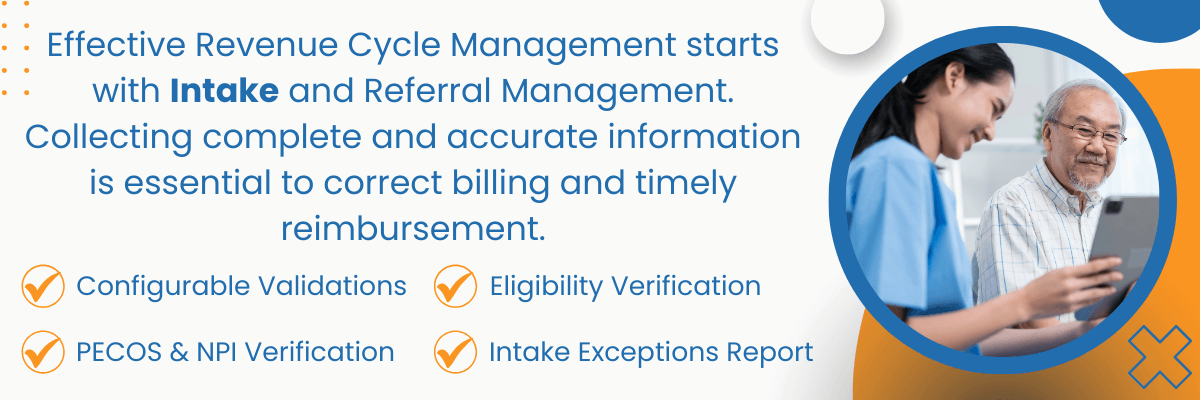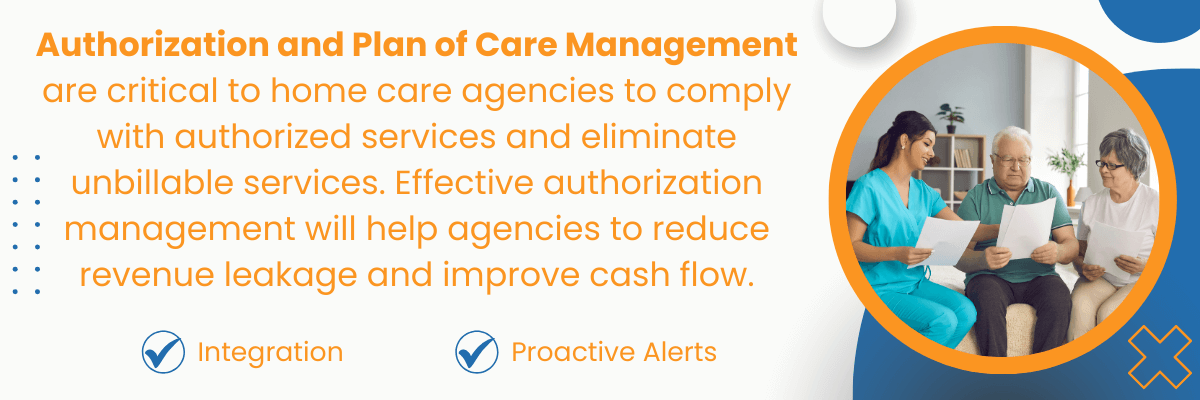Elevate Your Revenue Cycle: Essential Keys for Effective Home Care Management. Explore best practices in billing, documentation, and compliance to drive revenue growth.
This blog will discuss some critical features Home Care Software requires to manage revenue and collections to improve cash flow and the bottom line.
Overview
The demand for home health care services will grow as more elderly populations prefer to age at home. Even with the growing demand, home care agencies will face significant headwinds in the future. Falling reimbursements, increasing labor costs, and regulatory requirements will pose many operational challenges. Effective Revenue Cycle Management will improve operational efficiency, cash flow, and the bottom line for home care agencies.
The Revenue Cycle Management (RCM) process starts at intake and continues through authorization, scheduling, billing, and collections. Home Care Agencies must integrate the RCM process with operations to capture, bill, and collect revenue for all the services provided. Agencies should review the RCM process periodically and adjust the process to accommodate the changes in the patient and payer mix.
“Home Care Agencies must leverage technology and software to automate repetitive and time-consuming revenue cycle tasks. Management by Exception throughout the RCM process will help home care agencies to do more with less. ”
Keys to Effective Revenue Cycle Management for Home Care
Below are some of the critical features Home Care Software requires to manage revenue and collections to improve cash flow and the bottom line.
1. Intake
Effective Revenue Cycle Management starts with Intake and Referral Management. Collecting complete and accurate information, such as patient demographics, insurance, etc., is essential to correct billing and timely reimbursement. The following are some intake functions that will help home care agencies.
Configurable Validations: The software should be able to provide proactive alerts for missing patient information at the time of intake. These alerts will help the intake staff collect as much information as possible. Configuring the validations will help the agencies select the alerts based on their unique needs.
Eligibility Verification: The ability to verify eligibility in real-time at the time of referral or intake will help the agencies ensure the patient has the right coverage for the services. The software should also have the option to verify eligibility in batch mode to verify eligibility for current patients periodically. Automatic alerts for any discrepancies will be beneficial.
PECOS and NPI Verification: The ability to verify NPI (National Provider Identifier) and PECOS (Medicare Provider Enrollment, Chain, and Ownership System) during intake will eliminate future denial of claims.
Intake Exception Reports: Scheduled Intake Exception reports will help intake staff continuously monitor missing and mismatched information.
2. Authorization and Plan of Care Management
Authorization and Plan of Care Management are critical to home care agencies to comply with authorized services and eliminate unbillable services. One of the main reasons for denying claims is needing proper authorization for the services. Effective authorization management will help agencies to reduce revenue leakage and improve cash flow. The following are some of the critical features of authorization management.
Integration: Authorization Management must be integrated with intake, scheduling, clinical, and billing. The integration will eliminate the need for manual workarounds to manage authorizations.
Proactive Alerts: Proactive alerts for expiring authorizations will keep authorizations current and reduce unauthorized services. Validations and alerts to limit scheduling services outside authorized limits will improve compliance and minimize revenue leakage. Monitoring authorized and delivered hours during the authorization period will help agencies to optimize authorized hours for the patient.
3. Scheduling
Scheduling, in many ways, is the lifeline of a home care agency. Effective scheduling ensures optimal caregiver utilization, reduces travel costs, unbillable services, claim denials, and revenue leakage, and improves the bottom line. The following are some of the vital scheduling features for home care agencies.
Integration: Scheduling must be integrated with intake, authorization, clinical, billing, and payroll. Creating schedules from the authorization will improve scheduling and avoid scheduling outside authorization.
Configurable Validations: Software should be able to provide proactive alerts during scheduling to detect potential billing issues such as schedule beyond authorization, duplicate services, and missing information. Payer-related validations at the time of verification for billing will significantly reduce denials. Configurable validations will help home care agencies implement RCM policies when scheduling and reduce manual efforts during claims processing and collections.
Split Schedules: Private Duty Nursing and Non-Medical Home Care Agencies provide multiple services with different payers during shifts. Software should be able to split these schedules during billing automatically. Assigning appropriate services and payers at the time of billing will significantly reduce manual efforts at the billing time and reduce errors.
4. Billing And AR
Timely billing and collection are essential for home care agencies' cash flow and bottom line. Home Care Agencies still have many manual workarounds to meet disparate payer requirements leading to delays and errors in claims. Manual workarounds limit the opportunities to grow the agency. Home Care Software should accommodate payer requirements and automate many time-consuming tasks. The following are some of the features home care software should offer.
Integration: Billing and AR must be integrated with intake, authorization, scheduling, EVV, and billing. Information collected at each stage should flow through to billing without any manual efforts on the part of the billers.
Claim Scrubber: Configurable claim scrubber will be essential to validate claims based on the requirements of individual payers before submitting the claims. Claim Scrubber should be able to detect missing fields, authorization, rejected EVV submissions, etc., and alert the billers before the claims are sent to the payer. Sending clean claims will significantly improve reimbursement time and cash flow.
Configurable Formats: Software should be able to configure the claims formats to meet unique data requirements for payers. Data requirements vary from service to service. Some Medicaid Waiver programs might require invoices rather than claims. Home Care Software should be configurable to accommodate various billing requirements. Configuring billing formats will significantly reduce manual efforts to prepare and submit claims for payers.
Patient Statements: Agencies must send statements for private pay patients and patients with coinsurance. Agencies may also need to send statements to facilities when services are provided to patients in assisted living or independent living facilities. The ability to send statements will be essential to improve the cash flow for home care agencies.
Collections: Even after all the efforts to send clean claims to payers, insurance companies may still deny claims for various reasons. Home Care Software should provide the tools to queue denied claims for collections automatically. The tools should help the billers to manage the collection and the follow-up activities.
5. Reports
Reports and dashboards are vital in managing home care agencies' revenue, billing, and collection. Home Care Software must provide exception and financial management reports to improve revenue cycle management. Exception reports can identify patients with missing information, missing authorizations, schedules without charges, etc. Financial management reports, such as Aging Report, Trial Balance Report, etc., will help agencies to manage their revenue and improve revenue cycle management effectively.
Conclusion
Home Care Agencies should look for software that leverages technology to automate many repetitive and time-consuming tasks for billing and collection. CareVoyant understands the importance of Revenue Cycle Management for home care agencies. CareVoyant’s revenue cycle management tools will improve the operational efficiency of Revenue Cycle Management and the bottom line for home care agencies.
FAQs
-
Revenue Cycle Management (RCM) in home care involves processes like intake, authorization, scheduling, billing, and collections to manage and optimize revenue. It ensures operational efficiency, timely reimbursements, and a healthier bottom line for agencies.
-
-
Technology automates repetitive tasks, ensures data accuracy, provides proactive alerts, and integrates processes like scheduling and billing, significantly improving cash flow and operational efficiency.
-
Real-time eligibility verification confirms a patient's insurance coverage at intake, reducing the risk of claim denials due to ineligible services.
-
Proactive alerts notify agencies of expiring authorizations or scheduling outside authorized limits, helping prevent unauthorized services and revenue loss.
-
Integrated scheduling ensures compliance with authorizations, optimizes caregiver utilization, and reduces unbillable services, improving overall efficiency.
-
A claim scrubber validates claims for completeness and accuracy based on payer requirements before submission, reducing denials and improving reimbursement times.
-
Automating collections ensures denied claims are promptly addressed, streamlining follow-up activities and improving recovery rates.
-
Reports like Aging Reports and Trial Balance Reports help agencies monitor financial health, identify gaps in billing or collections, and make informed decisions.
-
Home care software should include essential features include real-time eligibility verification, configurable claim formats, proactive alerts, exception reports, integrated scheduling, and automated billing and collections.
About CareVoyant
CareVoyant is a leading provider of cloud-based integrated enterprise-scale home health care software that can support all home-based services under ONE Software, ONE Patient, and ONE Employee, making it a Single System of Record. We support all home based services, including Home Care, Private Duty Nursing, Private Duty Non-Medical, Home and Community Based Services (HCBS), Home Health, Pediatric Home Care, and Outpatient Therapy at Home.
CareVoyant functions – Intake, Authorization Management, Scheduling, Clinical with Mobile options, eMAR/eTAR, Electronic Visit Verification (EVV), Billing/AR, Secure Messaging, Notification, Reporting, and Dashboards – streamline workflow, meet regulatory requirements, improve quality of care, optimize reimbursement, improve operational efficiency and agency bottom line.
For more information, please visit CareVoyant.com or call us at 1-888-463-6797.
Request for Information
To learn more about CareVoyant Software and how we improve the operational efficiency of Home Healthcare Agencies, contact us:









